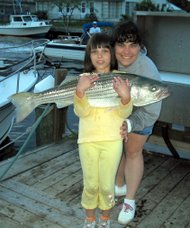The presses on this week's Hook, Line & Sinker section were minutes from rolling when a co-worker's message flashed across my screen:
"saxton says nmfs is talking about a 40 percent cut in the fluke quota."
I was stunned. Forty percent? Are they joking or are they just trying to kill off fishing?
According to a press release from the office of Rep. Jim Saxton, the National Marine Fisheries Service wants to reduce the 2008 fluke quota to 11.7 million pounds, 40 percent below the quota figure discussed when the Magnuson-Stevens act was reauthorized with the language extending the rebuilding period to 2013. Saston -- much to my surprise, I will freely admit -- has jumped all over it, sending a letter to NMFS director William Hogarth demanding to know what is going on and what possible reasoning there is for the cutback.
If I had to hazard a guess, the reason NMFS will say it needs to cut way back will be because of the surprisingly good landings this year, particularly here in New Jersey. Through no fault of our fisheries council, the 17-inch minimum and 8-fish bag has been more easily achieved than 16-and-a-half inches had been for the last few years. In the few years I've been editing the fishing section, the common complaint was high throwback ratios. I haven't heard that much this year, and the number of big fish being caught is amazing.
So chances are we will exceed the recreational quota -- possibly by a lot.
What makes this such a mess is that NMFS calculates the biomass in pounds, the quota in pounds, but the recruitment in number of fish. According to their estimates, the 2006 recruitment was 30.3 million fluke -- that's fish who survived to the age of 1. But when you start setting a quota in pounds, it gets just wacky. John Geiser has boiled it down before, but when you start setting quotas with minimum sizes of 17, 18 or 19 inches, the weight of those fish goes up significantly. So if you're talking 11.7 million pounds -- only 40 percent, or 4.68 million pounds of which is for recreational fishermen -- you're not talking about catching 11.7 million fish or 4.68 million fish. You're talking about perhaps half of those figures, if not less. If you've got a limit of catch of 19-inch fish that all weigh in at 2 pounds apiece, you've just removed 16 pounds of fluke in one trip. With literally hundreds of thousands of fishing trips in New Jersey alone, it's easy to see how quickly a quota can be overrun -- and that's not the fault of the angling public so long as they are abiding by the rules.
Then there's this biomass target of 214 million pounds. Why not just estimate the number of fish instead of the weight? It seems to me if you're estimating numbers of fish added to the biomass by recruitment, why not estimate numbers of fish removed from it? I'm sure NMFS can tell us just how many fluke an average commercial fishing net can hold. And we know that boat captains keep a log of how many fish are caught and how many are kept on their trips. Why not change the law that prevents using that catch data?
Is this really that hard for people to comprehend?
If you ask someone how much they weigh, you don't want them to tell you what size pants they wear because that doesn't answer the question.
But here is a serious question: Just why were the 1930s chosen as the basis for what they believe the fluke biomass should be? You can't possibly tell me they have anything close to accurate recordkeeping from a time when people were more interested in surviving the Great Depression than they would have been in counting how many fish there were in the seas.
The more I observe this fisheries management mess, the more strongly I believe NMFS officials and others in fisheries management simply want to put an end to fishing, especially from the recreational standpoint. Atlantic States Marine Fisheries Commission executive director John O'Shea's comments on the blackfish controversy and his absolute dismissal of any possible explanation for the problem except to blame the recreational anglers speak volumes.
If the National Marine Fisheries Service and the ASMFC are so hellbent on shutting down saltwater recreational fishing, then just institute a ban already and be done with it. Make the fines for saltwater fishing so prohibitive that no one will risk it. That way all these business folks who've been working hard for so long and living with this management Sword of Damocles for the last several years can just file for bankruptcy and find something else to do. Like flip burgers at McDonald's or scoop up after dogs at the park. Neither job may pay well, but at least they'd have some job security, unlike now, when so many wonder how much longer they can stay afloat -- no pun intended.
Killing these businesses slowly is like dragging a nice striper through the sand while you go get your camera to take your picture with the fish, then dragging it back to the ocean and releasing it, slime coating damaged by the grit, body stressed by the fight and the time out of the water. Death soon follows for fish treated that way. And the continual tightening of restrictions on anglers is doing the same thing to the businesses that depend on recreational fishing.
And that's just wrong.
Thursday, July 19, 2007
Subscribe to:
Posts (Atom)
